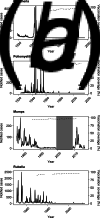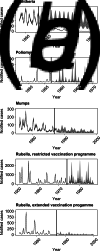Quantifying the impact of mass vaccination programmes on notified cases in the Netherlands
- PMID: 29534768
- PMCID: PMC9134361
- DOI: 10.1017/S0950268818000481
Quantifying the impact of mass vaccination programmes on notified cases in the Netherlands
Abstract
Vaccination programmes are considered a main contributor to the decline of infectious diseases over the 20th century. In recent years, the national vaccination coverage in the Netherlands has been declining, highlighting the need for continuous monitoring and evaluation of vaccination programmes. Our aim was to quantify the impact of long-standing vaccination programmes on notified cases in the Netherlands. We collected and digitised previously unavailable monthly case notifications of diphtheria, poliomyelitis, mumps and rubella in the Netherlands over the period 1919-2015. Poisson regression models accounting for seasonality, multi-year cycles, secular trends and auto-correlation were fit to pre-vaccination periods. Cases averted were calculated as the difference between observed and expected cases based on model projections. In the first 13 years of mass vaccinations, case notifications declined rapidly with 82.4% (95% credible interval (CI): 74.9-87.6) of notified cases of diphtheria averted, 92.9% (95% CI 85.0-97.2) cases of poliomyelitis, and 79.1% (95% CI 67.1-87.4) cases of mumps. Vaccination of 11-year-old girls against rubella averted 49.9% (95% CI 9.3-73.5) of cases, while universal vaccination averted 68.1% (95% CI 19.4-87.3) of cases. These findings show that vaccination programmes have contributed substantially to the reduction of infectious diseases in the Netherlands.
Keywords: Immunisation (vaccination); infectious disease epidemiology; public health; vaccine-preventable diseases.
Conflict of interest statement
M.J. Postma received grants and honoraria from various pharmaceutical companies, including GlaxoSmithKline, Pfizer and Sanofi Pasteur MSD, who are potentially interested in the subject matter of this Article. There are no other potential conflicts of interest.
Figures


Similar articles
-
[Quantifying the impact of mass vaccination programmes on notified cases in the Netherlands].Ned Tijdschr Geneeskd. 2018 Sep 20;162:D2983. Ned Tijdschr Geneeskd. 2018. PMID: 30306758 Dutch.
-
Effect of vaccination programmes on mortality burden among children and young adults in the Netherlands during the 20th century: a historical analysis.Lancet Infect Dis. 2016 May;16(5):592-598. doi: 10.1016/S1473-3099(16)00027-X. Epub 2016 Feb 10. Lancet Infect Dis. 2016. PMID: 26873665
-
Evaluation of the national immunisation programme in the Netherlands: immunity to diphtheria, tetanus, poliomyelitis, measles, mumps, rubella and Haemophilus influenzae type b.Vaccine. 2003 Jan 30;21(7-8):716-20. doi: 10.1016/s0264-410x(02)00587-x. Vaccine. 2003. PMID: 12531347
-
Pediatric immunizations.Curr Probl Pediatr. 1993 May-Jun;23(5):186-209. doi: 10.1016/0045-9380(93)90015-5. Curr Probl Pediatr. 1993. PMID: 8354078 Review.
-
[Vaccination against pneumococci and hepatitis B in the Dutch National Immunisation Programme].Ned Tijdschr Geneeskd. 2007 Jan 20;151(3):172-6. Ned Tijdschr Geneeskd. 2007. PMID: 17288341 Review. Dutch.
Cited by
-
Regional differences in historical diphtheria and scarlet fever notification rates in The Netherlands, 1905-1925: a spatial-temporal analysis.R Soc Open Sci. 2023 Nov 29;10(11):230966. doi: 10.1098/rsos.230966. eCollection 2023 Nov. R Soc Open Sci. 2023. PMID: 38034127 Free PMC article.
-
Disease burden of varicella versus other vaccine-preventable diseases before introduction of vaccination into the national immunisation programme in the Netherlands.Euro Surveill. 2019 May;24(18):1800363. doi: 10.2807/1560-7917.ES.2019.24.18.1800363. Euro Surveill. 2019. PMID: 31064637 Free PMC article.
-
Whole Genome Sequencing for Surveillance of Diphtheria in Low Incidence Settings.Front Public Health. 2019 Aug 21;7:235. doi: 10.3389/fpubh.2019.00235. eCollection 2019. Front Public Health. 2019. PMID: 31497588 Free PMC article. Review.
-
Estimated number of reported vaccine-preventable disease cases averted following the introduction of routine vaccination programs in Sweden, 1910-2019.Eur J Public Health. 2023 Dec 9;33(6):1188-1193. doi: 10.1093/eurpub/ckad169. Eur J Public Health. 2023. PMID: 37883058 Free PMC article.
References
-
- Anon (1999) Ten great public health achievements--United States, 1900–1999. MMWR Morbidity and Mortality Weekly Report 48, 241–243. - PubMed
-
- Anon (1999) Impact of vaccines universally recommended for children--United States, 1990–1998. MMWR Morbidity and Mortality Weekly Report 48, 243–248. - PubMed
-
- Hinman AR, et al. (2011) Vaccine-preventable diseases, immunizations, and MMWR--1961–2011. Morbidity and Mortality Weekly Report Surveillance Summaries 60(Suppl. 4), 49–57. - PubMed
-
- Hahne S, et al. (2009) Rubella outbreak in the Netherlands, 2004–2005: high burden of congenital infection and spread to Canada. The Pediatric Infectious Disease Journal 28, 795–800. - PubMed
Publication types
MeSH terms
LinkOut - more resources
Full Text Sources
Other Literature Sources
Medical

